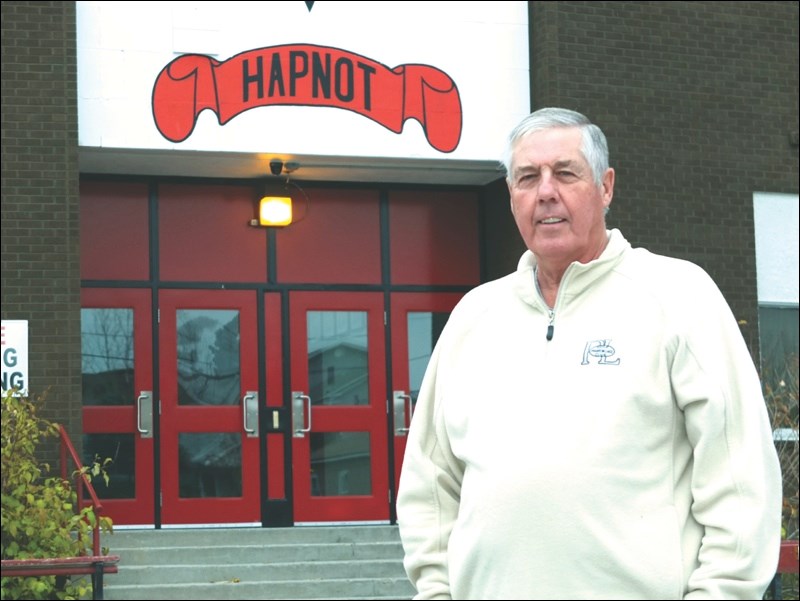Working for a school supply company in the early 1960s, Glenn Smith quickly learned that packing orders wasn’t his life’s dream.
Little did he know that he would soon begin a storied career delivering to students something just as important as paper and writing utensils: devoted teaching and administration.
Now Smith, a teacher-turned-principal-turned-trustee, has retired after nearly 50 years in education, almost all of them in Flin Flon.
“I thought it was probably time to step away and let fresh eyes have a look at things,” says Smith, 70, who did not seek re-election to the Flin Flon school board.
Smith had been on the board for eight years, but it was during the preceding decades that he made his biggest contribution to Flin Flon education.
Early job
Born and raised in Brandon, Smith took a job at Christie’s School Supplies, a landmark business in that city, after graduating from high school.
Dismayed by how unfulfilling the work was, Smith pondered his options. He decided to enroll at the Teacher’s College at Brandon University.
“I always got along really well with kids,” he says. “I guess going into education was the natural thing for me, in some ways, just because of that.”
Back then, the course to become a teacher lasted just one year. In 1965, after his year was up, Smith accepted a position in Killarney, Manitoba, near the US border.
He taught an assortment of subjects in grades 7 and 8. The work was fun but at $3,000 a year – the equivalent of $22,000 today – the pay wasn’t so great.
An ad for a job in Flin Flon caught Smith’s eye. McIsaac School needed a teacher. Pay would start at $4,000 a year.
“I thought ‘oh boy’ – that
was good money,” he recalls.
Smith’s decision to apply for the McIsaac job was sealed after his former neighbour in Brandon, a university professor, suggested Flin Flon had top-notch educators and was a first-class place to teach.
The arrival
In the fall of 1966, Smith began teaching junior high at McIsaac, which at that time
was located where the Ruth Betts Community School playground now sits.
At McIsaac, Smith strengthened his love for teaching and helping to shape young lives.
“It’s almost a little bit like [students are] your own children,” he says, “and so you have that personal interest and pride because a little bit of it is, you’ve assisted them – certainly not just you, but lots of other teachers, too, and parents and everybody else.”
After four or five years at McIsaac, Smith accepted an offer to teach phys-ed at Flin Flon’s high school, Hapnot Collegiate. He worked his way up to principal in 1978 and principal in 1981.
While some school principals are regarded as mythical creatures, rarely seen outside the confines of their paper-stacked offices, Smith was as hands-on as ever. He could often be found working with student council or the grad committee, or even coaching a sports team.
Strong rapport
No principal is universally loved by students, but Smith clearly had a strong rapport with many Hapnot pupils. At no time was their respect for him more evident than when the school board announced, in or around 1990, that it was removing Smith from his post.
The plan was to reassign Smith to the position of principal at Ruth Betts. It was no secret to anyone, least of all Smith’s students, that he was proud to be part of Hapnot and hoped to finish his career there.
In an unprecedented show of activism, a group of students left Hapnot to picket the school board office in protest.
“I was principal in my office at the time and somebody came to me and said, ‘The kids are leaving the school,’” recalls Smith. “I said, ‘What do you mean they’re leaving the school?’ They said, ‘Everybody’s left their class. They’ve walked out the door.’ Which, I mean, I don’t think that’s ever happened before or since. I couldn’t quite figure out what the heck was going on there.”
Bowing to student and public pressure, the board backed down. “Smitty,” as he was affectionately known, would remain at the helm of Hapnot until his retirement in 1999. With 18 years in, he is believed to be the longest-serving principal in the history of the high school.
After leaving Hapnot, Smith spent two years as a consultant for the Flin Flon School Division, running a program for international students and helping to devise a proposal for a vocational training centre.
By 2002, Smith, not quite 60, was in full retirement mode and loving it. Still, he couldn’t help but consider the suggestions of those urging him to get back into education in some capacity.
Feeling he still had something to offer, Smith let his name stand for the Flin Flon school board in 2006. He was acclaimed and quickly became one of the more vocal trustees, unafraid to criticize the provincial powers-that-be who insisted on amputating much of the board’s discretion.
In one well-known case, Smith challenged at length the very research behind Manitoba’s class size limits for early grades, a policy that carried a significant cost for schools.
According to Smith’s philosophy, people can lead either as a dictator or as part of a team. As time went on, he says, the province “tended to lead by telling.”
Gained insights
Through it all, Smith has gained insights into education few Manitobans possess. He has taught or administered thousands of students, worked with dozens of teachers, watched educational fads come and go, and witnessed an unprecedented evolution in technology.
As he looks back, Smith is quick to tell people that contrary to widespread belief, students are no worse today than they were when he began his career. Some students are a challenge in 2014 just as they were back in 1965.
Smith also believes contemporary schools rightly avoid lockstep approaches of the past; the system works to ensure students of differing academic abilities attain success.
“The mandate for schools now is to work with all kids and to help them grow and to improve,” says Smith, a married father of two and grandfather of four.
Perhaps above all else, these nearly five decades in education have taught Smith that no one, including educators, can predict an individual’s future.
“You’d be teaching a kid in grade 10, 11, 12 and they weren’t really very motivated,” he says. “They might have been nice kids, but school wasn’t a big interest to them and you think, ‘Oh my goodness, I’m worried about this kid. Is he ever going to be a success? Or is she going to be a success?’ I meet them 20 years later and, boy, are they a success by anybody’s standard three times over.”
As for the winding road that brought him to Flin Flon, Smith can’t help but laugh.
“I thought, ‘I’ll come here for one year and I’ll make some good money and then I’ll go somewhere else,’” he says. “I’m still here.”




